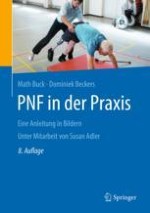Erschienen in:
2019 | OriginalPaper | Buchkapitel
3. Techniken
Zusammenfassung
In diesem Kapitel werden die einzelnen PNF-Techniken charakterisiert und deren Ziele benannt. Anwendungsmöglichkeiten, Indikationen bzw. Kontraindikationen werden beschrieben und ausführlich anhand von Beispielen und möglichen Modifikationen erläutert.
Anzeige














